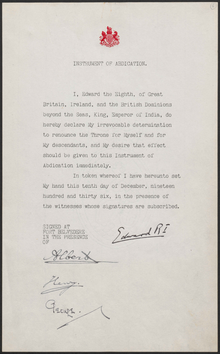His Majesty's Declaration of Abdication Act 1936
The law on the declaration of abdication of His Majesty 1936 ( English His Majesty's Declaration of Abdication Act 1936 ) was an Act of the British Parliament . It was passed on December 11, 1936 and made King Edward VIII's declaration of abdication from the previous day valid. At the same time, by law, Edward's brother Albert, Duke of York , succeeded him. Eduard abdicated in order to be able to marry his lover Wallis Simpson , which would not have been possible for him as king according to the will of the governments of Great Britain and the Dominions (see abdication of Edward VIII ).
The law passed through both houses of parliament in one day without additions. The Dominion governments ( Canada , Australia , the South African Union and New Zealand ) gave their permission for the law to apply in their respective countries. This agreement was since the Statute of Westminster in the year 1931 required. However, the law did not apply in the Irish Free State , which instead recognized the Duke of York as king through the External Relations Act .
The law was necessary for two reasons:
- First of all, there is no provision in British law in the event the monarch wishes to abdicate. The Act of Settlement of 1701 stipulates that in the throne senior descendant of Sophia of Hanover King of England is. The Act of Union in 1707 confirmed this rule for the whole of the Kingdom of Great Britain . The heir to the throne Sophias is therefore automatically monarch, whether he likes it or not. If he wants to abdicate, a law is needed to make it legally valid.
- Second, the law ensured that although the throne passed to Prince Albert, Duke of York, other descendants of Sophia of the Palatinate were not excluded from the line of succession. The descendants of Edward VIII would not have had any right to the throne and would not have been bound by the Royal Marriages Act 1772 .
The moment King Edward VIII gave his approval, known as the Royal Assent , to the law, he was no longer King of the United Kingdom of Great Britain and Northern Ireland . The throne fell immediately to Prince Albert, who the next day in St James's Palace in London to King George VI. was called out.
Web links
- Text of the law (English)
